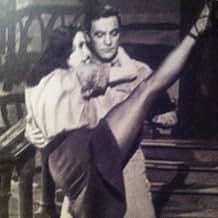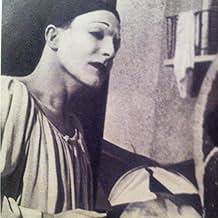IMDb RATING
6.4/10
1.1K
YOUR RATING
Three different stories are told through a notably unusual way - no words, just dance.Three different stories are told through a notably unusual way - no words, just dance.Three different stories are told through a notably unusual way - no words, just dance.
- Directors
- Writer
- Stars
- Awards
- 1 win & 1 nomination total
Luigi Faccuito
- Specialty Dancer
- (uncredited)
Diki Lerner
- Thief in 'Sinbad the Sailor'
- (uncredited)
Paddy Stone
- Speciality Dancer
- (uncredited)
- Directors
- Writer
- All cast & crew
- Production, box office & more at IMDbPro
Featured reviews
In what must have been a daring move in the 1950s, Gene Kelly created a film which was pure dance - three sequences (Circus, Ring Around The Rosy, Sinbad the Sailor).
Although not a great grosser in its day, time has been kind to this film and although it is not that well known, this film should be as it has a large amount of charm.
The first section, Circus, is a story about a clown and his unrequited love for the leading lady. A common love triangle presented in ballet, this is bittersweet and watchable.
In Ring Around The Rosy, a bracelet is lost and found and there is a charming duet to watch ... while Sinbad the Sailor includes a mix of real life and animation in the story of the sailor and the genie.
As good as any of Kelly's other work, this should be seen a lot more than it is.
Although not a great grosser in its day, time has been kind to this film and although it is not that well known, this film should be as it has a large amount of charm.
The first section, Circus, is a story about a clown and his unrequited love for the leading lady. A common love triangle presented in ballet, this is bittersweet and watchable.
In Ring Around The Rosy, a bracelet is lost and found and there is a charming duet to watch ... while Sinbad the Sailor includes a mix of real life and animation in the story of the sailor and the genie.
As good as any of Kelly's other work, this should be seen a lot more than it is.
This is the result of many years of effort on the part of Gene Kelly to create an all-dance film. Since he was a major-studio rather than an indie production child, Kelly convinced his home studio, MGM, to finally take on the project.
The final results, unfortunately, are mixed. The movie is simply average, with long stretches of off-timed and miscalculated action and uninspired choreography. Were Kelly to have collaborated in the writing, choreographing and direction departments, rather than taking everything on himself, things might have gone better.
The project was simply too great a task for Kelly; with other imput he might have made a film with greater perspective and flair. The story in "Circus" is only fair, and there's more pantomime than dancing for Kelly as Pierrot. Unfortantely, Jacques Ibert's music doesn't help either.
"Ring Around the Rosy" suffers from disjointed continuity, with awkward bridges and motivations. Too, the fine Tamara Toumanova as the Streetwalker provides a clash of styles when paired with Kelly as the Marine. Physically, their types don't match well, try as they will. Nor was this Andre Previn's finest compositional hour.
Finally, Roger Eden's adaptation of Nikolai Rimsky-Korsakov's score for "Sinbad the Sailor" makes for the most effective music in the film. Kelly at last gets to display his distinctive dancing manner, and does some impressive work (at age 44) in the interesting cartoon sequences.
It's not Kelly at his best, though, and "Inviation to the Dance" remains an interesting curio, earnest on effort and short on realization. Both dance fans in general and Kelly fans in particular will value this video in their collectiona.
The final results, unfortunately, are mixed. The movie is simply average, with long stretches of off-timed and miscalculated action and uninspired choreography. Were Kelly to have collaborated in the writing, choreographing and direction departments, rather than taking everything on himself, things might have gone better.
The project was simply too great a task for Kelly; with other imput he might have made a film with greater perspective and flair. The story in "Circus" is only fair, and there's more pantomime than dancing for Kelly as Pierrot. Unfortantely, Jacques Ibert's music doesn't help either.
"Ring Around the Rosy" suffers from disjointed continuity, with awkward bridges and motivations. Too, the fine Tamara Toumanova as the Streetwalker provides a clash of styles when paired with Kelly as the Marine. Physically, their types don't match well, try as they will. Nor was this Andre Previn's finest compositional hour.
Finally, Roger Eden's adaptation of Nikolai Rimsky-Korsakov's score for "Sinbad the Sailor" makes for the most effective music in the film. Kelly at last gets to display his distinctive dancing manner, and does some impressive work (at age 44) in the interesting cartoon sequences.
It's not Kelly at his best, though, and "Inviation to the Dance" remains an interesting curio, earnest on effort and short on realization. Both dance fans in general and Kelly fans in particular will value this video in their collectiona.
Gene Kelly was a visionary. He was passionate about his art and he was a master.
If you are passionate about your art and creativity, you will enjoy this celebration of dance. There is no dialogue to explain what is happening. There is no person telling you what to think. Kelly brings you to a moment and allows you to make the most of it.
Did you see love, pain, joy, desire, frustration, anger...congratulations!
If you are passionate about your art and creativity, you will enjoy this celebration of dance. There is no dialogue to explain what is happening. There is no person telling you what to think. Kelly brings you to a moment and allows you to make the most of it.
Did you see love, pain, joy, desire, frustration, anger...congratulations!
The first two segments of this film may or may not impress you, but do watch the third: "Sinbad the Sailor". Kelly plays an American sailor in an exotic Oriental market. He rubs an old lamp and a genie appears, played by an amazingly talented kid. After a bit of messing around,the genie gets a sailor suit, too. Then they open a book to a picture of a wonderous land. The genie transports them inside and all the rest features the two dancers (mostly Kelly alone) dancing with animation.This segment is much longer than any other live-plus-animation sequence until Mary Poppins excepting, possibly Song of the South whose sequences were nowhere near so complex as this. Kelly dances with an animated dragon (that wraps around him), into a harem, is chased by the Sultan's guards, has a long sequence with one harem girl, and then a very long sequence with the guards. This is amazing work for 1952, especially when you remember that every bit of the animation is hand-painted on cels. Hanna-Barbera (then with MGM doing Tom and Jerry directed the animation. (Kelly also did a famous dance number with Jerry in Anchors Aweigh eight years earlier.) Walt Disney advised. This is swell stuff and any fan of animation should give it a look.
No wonder INVITATION TO THE DANCE found no audience at the box office. The first two musical sequences, "Circus" and "Ring Around the Rosy" are monumental bores dragged down by pedestrian stories and, in the second one, inept use of camera trickery to speed up the action.
But the third, "Sinbad the Sailor," makes expert use of the Rimsky-Korsakov ballet score and makes dazzling use of animated effects, especially for the dancing between Kelly and a couple of Arabian guards which are highly original, intricate and amusing examples of combining live action with animation. It's the kind of originality sadly missing in the previously mentioned stories.
The "Sinbad" highlight almost makes up for the rest of the film with its own brand of originality--but alas, the first two sequences are enough to turn many viewers away from watching the final segment.
Summing up: Easy to see why this one failed miserably to attract a target audience with either high or low brow tastes.
But the third, "Sinbad the Sailor," makes expert use of the Rimsky-Korsakov ballet score and makes dazzling use of animated effects, especially for the dancing between Kelly and a couple of Arabian guards which are highly original, intricate and amusing examples of combining live action with animation. It's the kind of originality sadly missing in the previously mentioned stories.
The "Sinbad" highlight almost makes up for the rest of the film with its own brand of originality--but alas, the first two sequences are enough to turn many viewers away from watching the final segment.
Summing up: Easy to see why this one failed miserably to attract a target audience with either high or low brow tastes.
Did you know
- TriviaGene Kelly's original intention was to make a film that would educate mainstream audiences about professional dancing in the world. To this end, he wanted to cast the greatest dancers in Europe for the four segments in leading roles. He himself would appear in only one - the Popular Song sequence, which ended up being cut. MGM, however, refused to allow the picture unless he appeared in all of them. Many of the professionals who worked in the film agreed that this was one of the film's great weaknesses.
- GoofsDuring the "Scheherazade" sequence, the color of the palace guard's costume changes from green to blue.
- ConnectionsEdited into American Masters: Gene Kelly: Anatomy of a Dancer (2002)
- SoundtracksCircus
Music by Jacques Ibert
Performed by The Royal Philharmonic Orchestra, conducted by John Hollingsworth
Danced by Gene Kelly, Igor Youskevitch and Claire Sombert
- How long is Invitation to the Dance?Powered by Alexa
Details
- Release date
- Country of origin
- Language
- Also known as
- Invitation to the Dance
- Filming locations
- Production company
- See more company credits at IMDbPro
Box office
- Budget
- $1,500,000 (estimated)
- Runtime
- 1h 33m(93 min)
- Aspect ratio
- 1.37 : 1
Contribute to this page
Suggest an edit or add missing content
































